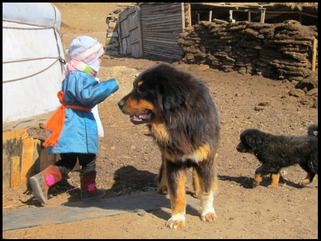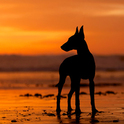Mongolian Bankhar ProjectCoordinator: Bruce Elfstrom MS (Nomadic Guardian's Foundation), Douglas Lally (Scientific Field Coordinator),
Scientific Team: Carol Beuchat PhD (Institute of Canine Biology, and UC Berkeley), Sundev Gombobaatar PhD (Univ of Mongolia), Pieter Oliehoek PhD (Institute of Canine Biology), Adam Boyko PhD (Cornell Univ), Bridgett VonHoldt PhD (Princeton Univ). (launched January 2014) |
REPORTS FROM THE FIELD
|
 © Bruce Elfstrom
© Bruce Elfstrom
Background
For hundreds of years, Mongolia's nomadic herders have relied on a native dog, the Bankhar, to protect their livestock from predation by the Mongolian gray wolf and snow leopard. This ancient and effective way of guarding livestock was lost during the Soviet occupation. Since then, the nomads have turned by necessity to shooting and poisoning potential predators, which are now threatened by diminishing numbers.
Bruce has seen firsthand the devastation to the lives of a Nomadic family should a wolf or leopard take some of their stock. "...I was amazed, one evening a family lost 7 colt horses...". In 2004, with his partners in Mongolia, Bruce launched The Nomadic Guardian's Foundation with the goal of returning the Bankhar dog to its traditional role as protector of the livestock for the nomads, saving both the dogs and the wolves from extinction in an ecologically sound way. This is a Mongolian solution to a Mongolian problem based on ancient Mongolian tradition.
For hundreds of years, Mongolia's nomadic herders have relied on a native dog, the Bankhar, to protect their livestock from predation by the Mongolian gray wolf and snow leopard. This ancient and effective way of guarding livestock was lost during the Soviet occupation. Since then, the nomads have turned by necessity to shooting and poisoning potential predators, which are now threatened by diminishing numbers.
Bruce has seen firsthand the devastation to the lives of a Nomadic family should a wolf or leopard take some of their stock. "...I was amazed, one evening a family lost 7 colt horses...". In 2004, with his partners in Mongolia, Bruce launched The Nomadic Guardian's Foundation with the goal of returning the Bankhar dog to its traditional role as protector of the livestock for the nomads, saving both the dogs and the wolves from extinction in an ecologically sound way. This is a Mongolian solution to a Mongolian problem based on ancient Mongolian tradition.
Bruce's team will be making a trip to Ulaanbaatar in February 2014 with the following goals:
From his trips to Mongolia over the years leading overland expeditions with his company, Overland Experts, Bruce has established relationships with many people and organizations that are coming together to help with the project. Bruce is committed to learning as much about the history and genetics of this rare breed as possible and is partnering with the Institute of Canine Biology to facilitate those efforts.
If you've never seen one of these dogs - or even if you have - check these out -
- locating Bankhar that are still being used as working dogs;
- gathering blood samples for molecular genetics;
- inspecting kennels at Hustai National Park for possible use;
- establishing breeding pairs in residence with sheep under the guidance of Dr Sundev Gombobaatar (Univ. of Mongolia).
From his trips to Mongolia over the years leading overland expeditions with his company, Overland Experts, Bruce has established relationships with many people and organizations that are coming together to help with the project. Bruce is committed to learning as much about the history and genetics of this rare breed as possible and is partnering with the Institute of Canine Biology to facilitate those efforts.
If you've never seen one of these dogs - or even if you have - check these out -
- Some wonderful photos
- Great video (check out the whelping box!)
- More vintage video
- Bankhar at a Mongolian dog show
- Stunning photography of Mongolia
- More gorgeous photography from one of project leader Bruce Elfstrom's trips to Mongolia

